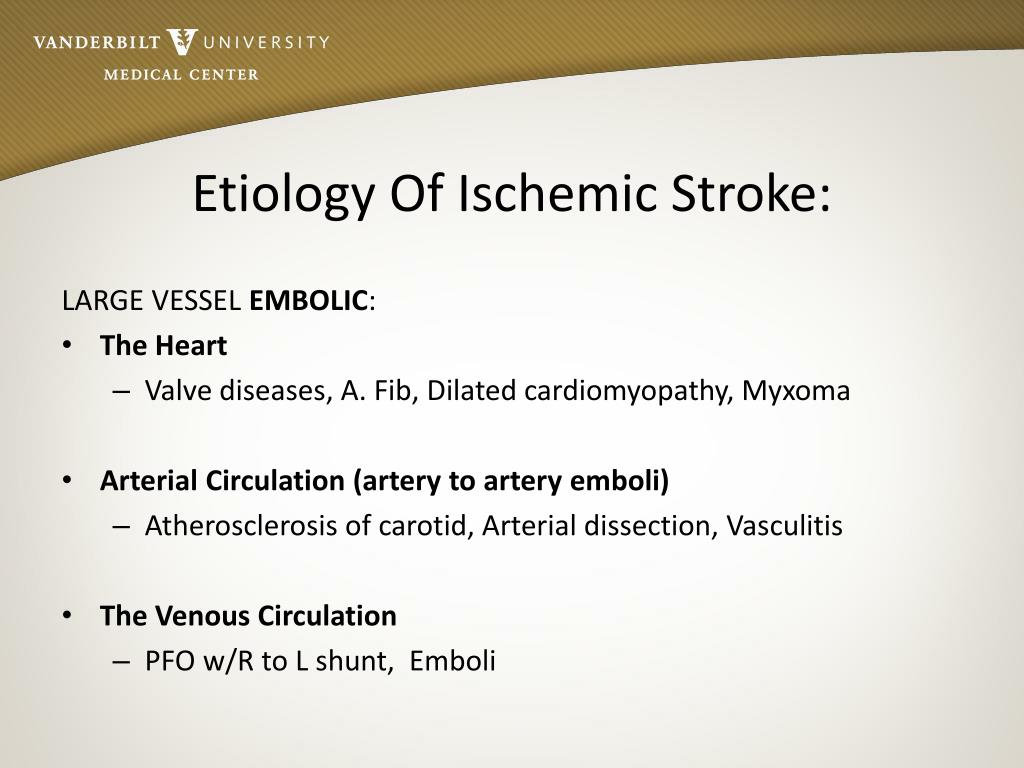Etiology of Young Stroke. The classification of stroke mechanism depends on the presence of risk factors for stroke preexisting condition or circumstance epidemiologically related to stroke and etiologies disease.

A I Schemic Stroke Etiology Download Table
Usually the management of stroke in young adults warrants an exhaustive.

Etiology of strokes. Hemorrhage is characterized by too much blood within the closed cranial cavity while ischemia is characterized by too little blood to supply an adequate amount of. The most common etiologies were metabolic disorders such as mitochondrial encephalopathy lactic acidosis and stroke MELAS and homocystinuria 25 cardiac disorders 17 and coagulopathy such as a homozygous mutation in the MTHFR gene and a factor V Leiden mutation 17. Symptoms or signs caused by reversible edema without infarction or hemorrhage do not qualify as stroke.
Stroke caused by cerebral venous thrombosis - infarction or hemorrhage in CNS due to thrombosis of cerebral venous structure. Etiology of Young Stroke While a greater proportion of strokes are due to subarachnoid haemorrhage and intracranial haemorrhage in young adults 4055 compared to the general stroke population 1520 17 26 37. 2 16 Although two-thirds of strokes occur in those over the age of 65 it is observed now that the prevalence is becoming high among younger age group and low socioeconomic status.
Most strokes 87 are ischemic strokes. Etiology of motor or sensory stroke. Etiology of ischemic stroke is often multifactorial and therefore an ideal ischemic stroke classification should both comprise all underlying pathologies that could potentially concur to an index event and emphasize the most likely etiological and pathophysiological mechanism.
Brey Bruce Coull J. 1 An ischemic stroke happens when blood flow through the artery that supplies oxygen-rich blood to the brain becomes blocked. A prospective study of the predictive value of clinical and radiological features.
Current smoking consumption of meat more than four times weekly and a history of hypertension or intermittent claudication were each associated with increased risk in multivariate models for all strokes and for all first-ever strokes. Babikian José Biller Robin L. While a greater proportion of strokes are due to subarachnoid haemorrhage and intracranial haemorrhage in young adults 4055 compared to the general stroke population 1520 17 26 37 cerebral infarction is still most commonAn increased risk of cerebral infarction among young adults with conventional vascular risk factors is observed particularly in.
Blood clots often cause the blockages that lead to ischemic strokes. CAA is caused by beta-amyloid deposition in the walls of medium- and small-sized arteries restricted to the brain cortex overlying leptomeninges and cerebellum. Most strokes occur in the first weeks after the infarct but some risk for stroke remains for an indefinite time.
The two broad categories of stroke hemorrhage and ischemia are diametrically opposite conditions. Therefore we assessed the etiology of ischemic strokes despite anticoagulation with vitamin K antagonists VKA or non-VKA oral anticoagulants NOACs. A hemorrhagic stroke happens when an artery in the brain leaks blood or ruptures breaks.
Stroke grows exponentially from 30 years of age and etiology varies with age. Albers Pierre Amarenco Viken L. 1Department of Neurology Cleveland Clinic Foundation OH.
Accounts for a significant number of primary hemorrhagic strokes specifically in older people. The majority of strokes after AMI are thought to be embolic arising from left ventricular wall mural thrombi but a number may be atherothrombotic or in the acute phase secondary to hemodynamic compromise. A known etiology was identified in 583 of patients.
Patients with known atrial fibrillation AF treatment with VKA or NOAC and acute ischemic stroke admitted between 2015 and 2018 1st half were identified from the hospital database. Prevalence remains low in people under 55 years. Etiology was un-known in 7 1707 children after necessary available investigations.
Donald Easton Camilo R. Stroke in the young patient is different from stroke in the elderly in several aspects such as etiology and prognosis. Consumption of 1 to 20 gd alcohol in the preceding week was associated with a significant reduction in the risk of all strokes all ischemic strokes and of primary.
Chimowitz MI1 Furlan AJ Sila CA Paranandi L Beck GJ. The main etiology of strokes was intracranial infection causing strokes in 23 5609children and majority of children 7826 in this group were below five years.